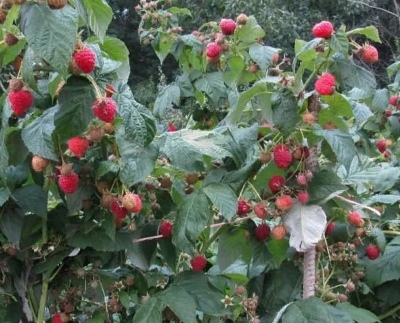
- Repairability: Yes
- Berry color: bright red
- Taste: pronounced, sweet, sour
- Ripening period: average
- Berry weight, g: 11
- Yield: up to 6 kg per bush
- Frost resistance: winter hardy
- Drop off location: from the south side along the fence or house
- Fruiting period: from July to October
- Spike location: all over the run
A new variety of raspberries with the loud name Generalissimo has proven itself among summer residents. It grows well without props, is thermophilic, bears fruit abundantly in the south, keeping all the berries on the bushes without shedding. After harvesting, the crop is easily transported, while the presentation does not suffer.
Description of the variety
Generalissimo forms erect bushes up to 100 cm high, medium-sized, with powerful, wide and thick shoots covered with thorns. The leaves are green, large, cover the shoots rather densely. Lateral shoots are formed abundantly on the main shoots.
Ripening terms
A remontant variety, with an average ripening period, it can give 2 harvests from July to October.
Yield
In terms of yield, the Generalissimo demonstrates high rates. Up to 6 kg of ripe berries are collected from the bush.
Berries and their taste
Raspberry Generalissimo gives berries oblong in shape up to 4 cm long and weighing 11 g. Large fruits have a bright red color, juicy flesh. The taste is sweet with sourness, pronounced, without extraneous flavors.

Growing features
The raspberry bushes of the Generalissimus variety are usually formed in rows, with a distance between seedlings of 1 m and a strip of 2 m between adjacent planting lines. When choosing a bush growing scheme, the entire area is divided into rectangular blocks of 1.5 × 2 m. Plants are placed in the corners. And also, tape planting is practiced in 3 lines with a distance of 75 cm between bushes and 2 m in rows. When growing, the raspberry is thinned out so that no more than 5 fruitful shoots are per bush.
Site selection and soil preparation
The optimal soil for the raspberry is light, fertile. The choice of a place for planting the Generalissimo's bushes is made in favor of the southern side of the site, along the perimeter of the fence or building. It is important that the plants get enough sunlight and that the groundwater does not run close to the roots.


Pruning
Periodic pruning by the Sobolev method is recommended. To increase productivity, the entire surface of the bush is cut out after fruiting. In this case, fruiting becomes one-time, later and amicable - on the branches of the current year.Summer pruning is carried out by removing 20 cm of the length of the branches. In the spring, it is carried out only on secondary shoots, if the bush has not been completely freed from the aboveground part.

Watering and feeding
The optimal irrigation method is drip, with automatic irrigation at regular intervals. Especially important is the flow of liquid during active growing season, until the end of fruiting. The soil is kept moist to a depth of 30-40 cm. Top dressing is preferably done using organic raw materials, for the prevention of diseases and soil deoxidation, dusting and dusting with ash.


Frost resistance and preparation for winter
The variety is winter-hardy. It does not need additional shelter, it can easily survive short-term cold weather under the snow. In the Urals and Siberia, other cold regions does not take root. The main measure of preparation for winter is the removal of the aerial part of the plant. In this case, it will remain to mulch the roots abundantly, cover them with a layer of humus so that the raspberries overwinter successfully.

Diseases and pests
The Generalissimo was originally bred with high resistance to diseases and pests. The variety is not affected by the most common fungal diseases, but it can be sick with anthracnose, purple spot. Of the pests for raspberries, the Generalissimo is especially dangerous aphid.

Unfortunately, raspberries, like other plants, do not bypass various diseases and pests. Only by armed with the knowledge and the necessary means for this, you can cope with such troubles. To help the plant, it is very important to be able to recognize the disease in time and begin timely treatment.
Reproduction
The main method of reproduction is vegetative; shrubs are rarely grown from seeds. Young cuttings are harvested in autumn, in spring they are transferred to open ground to a permanent place. And also raspberries lend themselves well to reproduction by separating root layers.

Review overview
According to summer residents, the Generalissimo feels great both in large areas and in small areas.Not everyone appreciated the repairability of the variety; in cold regions they try to grow it in an annual culture, shifting the timing of the harvest. So the berries have time to get enough sun for ripening, a set of sweetness. In partial shade or with a small amount of light, the bushes develop worse, and sourness prevails in the fruits.
It is noted that the Generalissimo produces very large berries, reminiscent of forest berries in aroma. The variety is planted to obtain fruits for sale or for personal consumption, appreciated for its selective appearance, simplicity of agricultural technology and strong immunity. Harvesting is somewhat complicated due to the abundance of thorns on the branches.







































































